|
The
Simplicity of American Colonial Redware
by
Bob Brooke
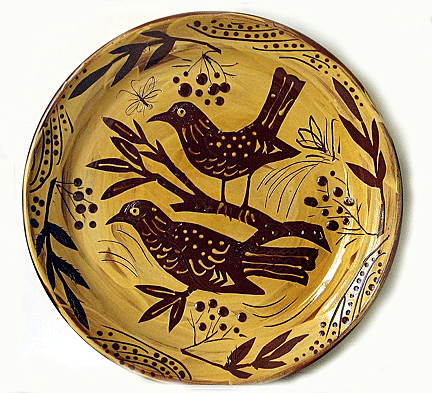 Redware
was the first pottery made in the American colonies. Potters made it
from local red clay. Early American colonists produced pottery mostly
for their own use. Without kilns that could produce high-firing
temperatures, they typically produced low-fire earthenware Redware
was the first pottery made in the American colonies. Potters made it
from local red clay. Early American colonists produced pottery mostly
for their own use. Without kilns that could produce high-firing
temperatures, they typically produced low-fire earthenware
From a technical standpoint, redware is the overall term applied to all
clays which have a porosity above 5 percent when fired. Simply put, the
fired clay must be within 5 percent of being wholly watertight, or
vitrified. Redware cannot be made completely watertight because of its
porosity—much like clay flower pots—so potters had to glaze their wares
to increase their usefulness.
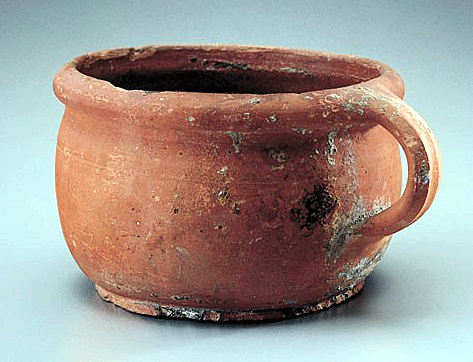 In
the majority of cases the "red" is the natural reddish-brown of the
fired clay, the same sort of color as in terracotta or red brick. The
color to which clay turns when fired varies considerably with its makeup
and the firing conditions. The colors of redware actually range from
reds to browns to yellows, blacks, greys, and whites. In
the majority of cases the "red" is the natural reddish-brown of the
fired clay, the same sort of color as in terracotta or red brick. The
color to which clay turns when fired varies considerably with its makeup
and the firing conditions. The colors of redware actually range from
reds to browns to yellows, blacks, greys, and whites.
During the 17th to 19th centuries, European potters produced unglazed
stoneware, mostly for teapots, jugs and mugs. Colonists had to import
these wares are great expense. American redware, on the other hand, was
inexpensive and used for a wide variety of kitchen and dining functions,
as well as objects such as chamber pots.
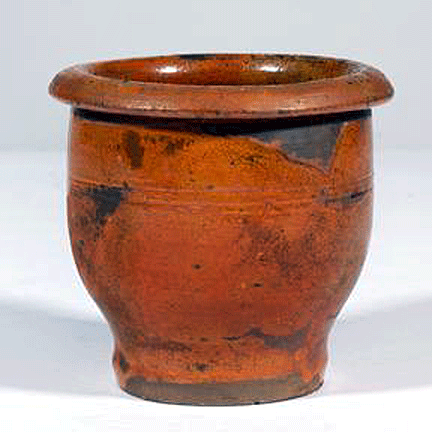 Utilitarian
items such as crocks, chamber pots, butter pots and one- or two-handled
jugs were the most common items produced. Not always of the best
quality, pieces were crude and coarse in appearance, with minimal
glazing—often on half the container—and rusty orange to dark brown clay
or glaze colors. Because imported ceramics were expensive, colonists had
to tolerate less-than-perfect homemade wares. Utilitarian
items such as crocks, chamber pots, butter pots and one- or two-handled
jugs were the most common items produced. Not always of the best
quality, pieces were crude and coarse in appearance, with minimal
glazing—often on half the container—and rusty orange to dark brown clay
or glaze colors. Because imported ceramics were expensive, colonists had
to tolerate less-than-perfect homemade wares.
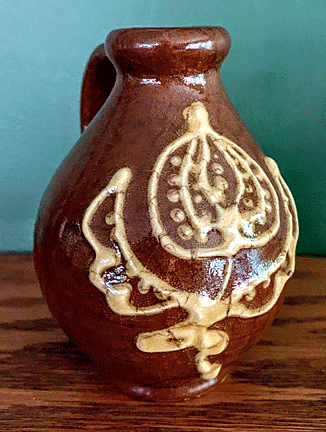 Historians
believe one of the reasons for the poor quality early American redware
was that, at least in rural areas, potters worked two jobs, farming and
pottery. Rural areas desperately needed pottery for the various forms of
housekeeping, and many farmers took to supplying the needs of their
neighbors in their leisure hours. The rigors of farm life certainly
couldn’t have been conducive to regularity or uniformity of pottery
production. And, certainly, these rural potters were unlikely to have
trained in one of the great pottery centers of Europe. In fact, many may
have been self-taught. Historians
believe one of the reasons for the poor quality early American redware
was that, at least in rural areas, potters worked two jobs, farming and
pottery. Rural areas desperately needed pottery for the various forms of
housekeeping, and many farmers took to supplying the needs of their
neighbors in their leisure hours. The rigors of farm life certainly
couldn’t have been conducive to regularity or uniformity of pottery
production. And, certainly, these rural potters were unlikely to have
trained in one of the great pottery centers of Europe. In fact, many may
have been self-taught.
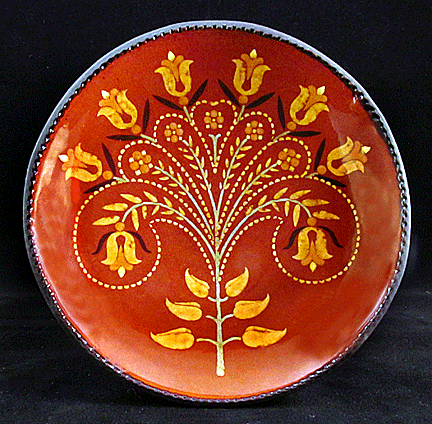 Though
American redware usually had a reddish body, whether glazed or not,
potters often gave it a white or other glaze, either tin-glazed or
lead-glazed. Depending on the locality, this was the basic utilitarian
pottery of Colonial America. It was often complemented by imported or
American stoneware for large vessels where the added strength was
useful. Though
American redware usually had a reddish body, whether glazed or not,
potters often gave it a white or other glaze, either tin-glazed or
lead-glazed. Depending on the locality, this was the basic utilitarian
pottery of Colonial America. It was often complemented by imported or
American stoneware for large vessels where the added strength was
useful.
Besides producing plainer wares for everyday use, Colonial potters also
created fancy platters and jugs that were glazed, often in yellowish
tones, and painted with bold folk art designs. This practice continued
well into the 19th century. But these special decorated pieces were
rather uncommon. Unlike everyday redware, potters stamped many of these
fancy pieces with dates and signatures.
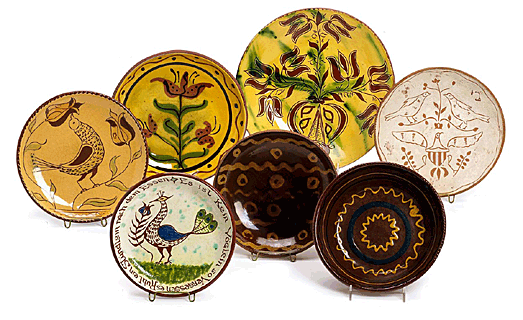
Making Colonial Redware
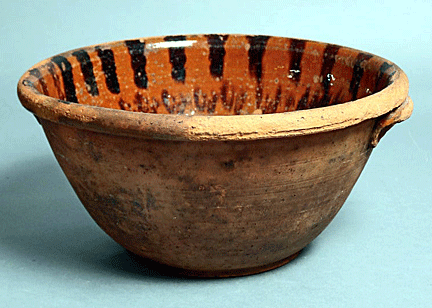 The
technique used by Colonial potters was rather simple. They pressed soft
clay over a mold which formed the shape of the vessel. Then they cut a
notched rim with a hand-held, wooden or metal coggle, a wheel designed
for making decorative impressions, similar to a pie crust crimper. Some
Colonial potters often decorated the interior of their pieces with a
liquid white clay that they poured into the vessels. To create a
watertight surface and still keeping the red color, they coated the
interior of their pieces with a clear, lead glaze, then fired them. The
technique used by Colonial potters was rather simple. They pressed soft
clay over a mold which formed the shape of the vessel. Then they cut a
notched rim with a hand-held, wooden or metal coggle, a wheel designed
for making decorative impressions, similar to a pie crust crimper. Some
Colonial potters often decorated the interior of their pieces with a
liquid white clay that they poured into the vessels. To create a
watertight surface and still keeping the red color, they coated the
interior of their pieces with a clear, lead glaze, then fired them.
 Potters
employed semi-liquid clay or slip both as a wash before firing and as a
decoration, forming patterns, names, or sayings on the exterior.
Sgraffito was a technique of cutting away of the surface layer to reveal
a different base color. Germans in Pennsylvania made decorated pottery
from the mid-18th to the 19th century, using techniques from their
homeland in the Rhineland. Using local yellow clay, they produced
sgraffito and slip pottery. Potters
employed semi-liquid clay or slip both as a wash before firing and as a
decoration, forming patterns, names, or sayings on the exterior.
Sgraffito was a technique of cutting away of the surface layer to reveal
a different base color. Germans in Pennsylvania made decorated pottery
from the mid-18th to the 19th century, using techniques from their
homeland in the Rhineland. Using local yellow clay, they produced
sgraffito and slip pottery.
Generally, Germans influenced pottery in the northern states while
English, Germans, and Africans, mostly working as slaves, created
pottery in the South. New England potters made redware for household use
from the 1770s to the mid-19th century. Connecticut became famous for
bean pots, and Vermont became known for crude pottery figures of cows,
dogs and lions from Bennington, and mottled pottery with a brown glaze
from Bennington and Burlington.
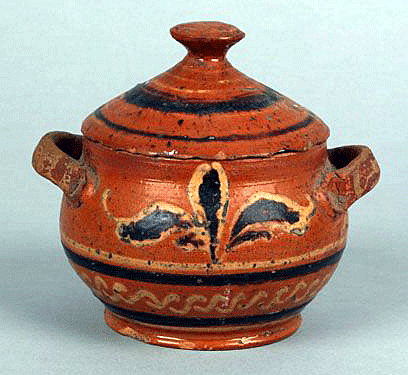 Early
Southern potters used English techniques to make their wares. Shapes
were more ovoid, with rounded shoulders. Shapes became more generally
rounded, then straighter. Alkaline and slip glazing were common. Early
Southern potters used English techniques to make their wares. Shapes
were more ovoid, with rounded shoulders. Shapes became more generally
rounded, then straighter. Alkaline and slip glazing were common.
Redware is distinctly American. It developed out of necessity, local
materials, and ingenuity. Today, it represents an era in the early
formation of the United States.
<
Back to Antiques Archives
Next Article > |
